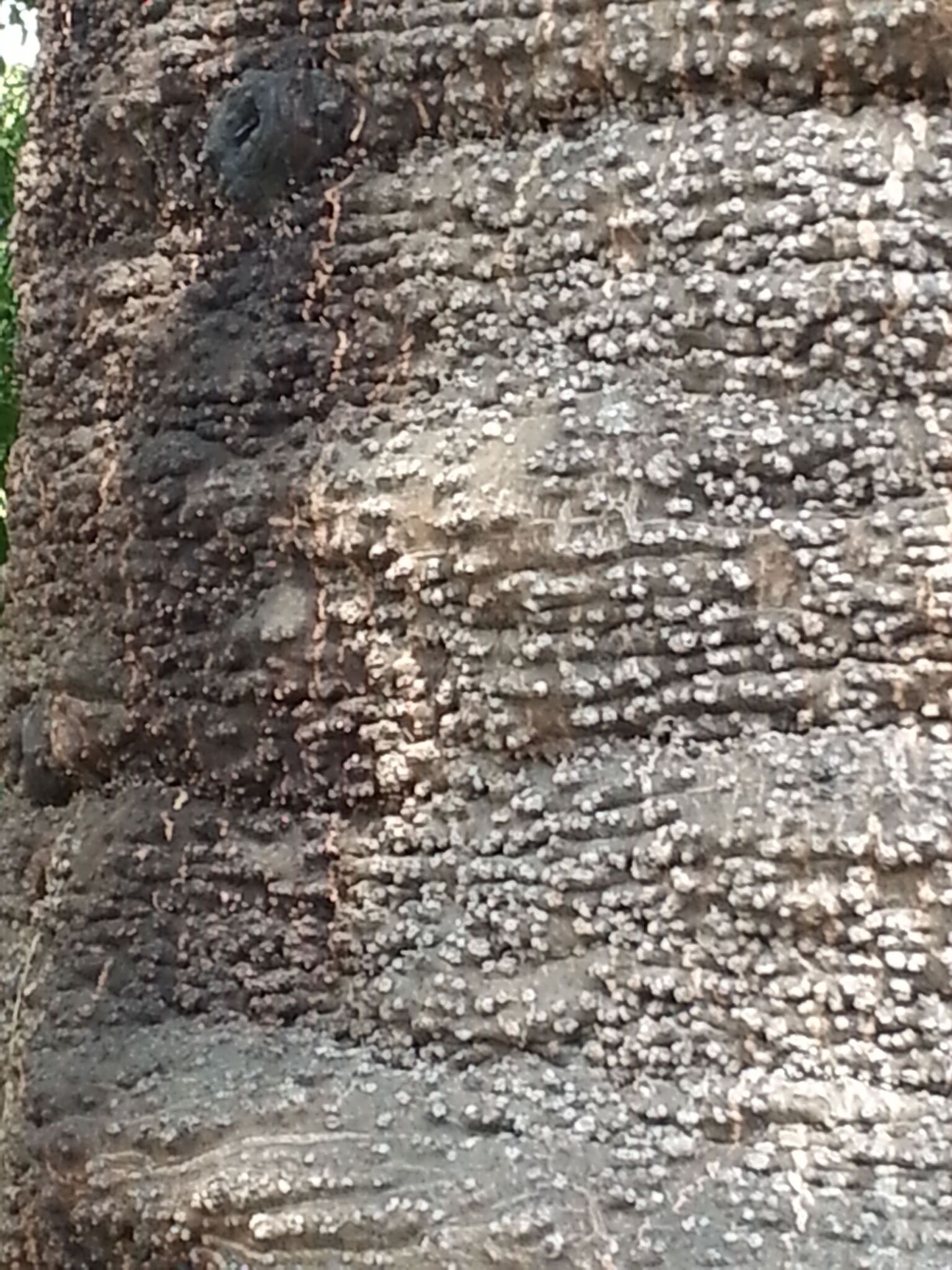
A large, domed tree to 45 m tall but much smaller in cultivation. Branches in whorls of 10-15, horizontal or arching downwards on older trees, the foliage in large clusters at the branch tips. Bark greyish-black, often warted and wrinkled like an elephant hide. Branchlets long and drooping. Leaves flat, spreading, tapering at both ends and sharp-pointed at the tip. The larger branchlet leaves are arranged on each side of the branchlet and are up to 5 cm long and 1 cm wide, the smaller stiff ones spiralling around it. Male cones to 18 cm long with diamond shaped scale tips, they hang from the ends of the upper branches mostly in Sept.-Oct. Together with those of the Monkey Puzzle, these are the world's largest male conifer cones. Female cone massive and similar in appearance to a pineapple, borne erect on the uppermost branches every few years (cones 31 cm long by 22 cm wide and weighing 5 kilos have been collected at the Royal Botanic Gardens Melbourne), shed usually in Feb.-May.
Grows naturally in disjunct populations between Gympie and the Bunya Mts in SE Queensland and 45 km inland from Port Douglas, N Qld, often with Hoop Pine and mostly as an emergent in tropical rainforest. A popular planting of the nineteenth century through the old British Empire and a major landscape feature of older public and private gardens in Australia but now rarely grown. It survives without difficulty the occasional frosts of Melbourne, Canberra and Tasmania. The common name Bunya is derived from the Aboriginal name for this tree.
Qld.
The seeds were eaten by Aboriginals at three-yearly feasts when the yield peaked. They were prepared by roasting or boiling and are said to have the flavour of roast parsnip. Has been used as a timber tree.
Domed canopy; leaves variable - from short and spirally arranged to more or less linear-lanceolate, 2-ranked and with a narrowed base; cones massive; cf. A. araucana.
Nelson (1991).
SA: Belair (6 trees near Karka Pavilion & 2 trees near Long Gully kiosk, all probably ptd c. 1904); Hackney (in front of Athelney House, Athelney Ave, St Peters College with double leader); Mt Gambier (Umpherston Cave; Hospital); Mylor (near banks Onkaparinga River E side of bridge at Rockford Estate along Bridgewater to Echunga Rd); Penola (Yallourn Park). NSW: Armidale (University &Central Park); Bathurst (Catholic Cathedral; Machattie Park); Camden (Macarthur Anglican Church; St John's Anglican Church); Goulburn (Belmore Park; Orana Pre-school); Mittagong (Public Library); Old Bonalbo (30.5 m in 1975, ptd 1870); Orange (Cook Park; Newstead Bowling Club); Ournie (Jephcott Arboretum, several); Strickland State Forest (30 m in 1974, ptd 1890); Sydney (Epping, Forest Park Blaxland Rd frontage, c. 30 m tall; Woollahra Council Chambers 100 years old); Yass; Wagga Wagga (Collins Park, Victory Memorial Gds); Tamworth (car park cnr Marius &Fitzroy streets, 17 m tall in 1992 100 years old; St John's Anglican Church, 19 m tall, c. 110 years old in 1992; Upper St, 23 m tall in 1992); Wellington (Park). VIC: Albury (Bot. Gds, 2 trees); Ballarat (Bot. Gds); Beechworth (Town Hall Gardens, planted 1875); Benalla (Bot. Gds, many trees); Bendigo (Rosalind Park; White Hills Cemetery); Berwick (2 trees at rear Fountain Gate Shopping Centre); Bright (old avenues in two parallel streets); Caulfield (Park); Box Hill (cemetery by office); Castlemaine ('Buda'); Colac (Bot. Gds); Essendon (Queens Park, 3); Fitzroy (Gardens); Geelong (Bot. Gds, row of 12 trees); Harcourt (2); Hawthorn (Central Gardens); Heidelberg (Park); Kew (Boroondara Cemetery, 2; Carey Baptist Grammar School, small-leaved variant); Maldon ('Bunya' &cnr Templeton &Camp Sts); Malvern (Toorak Teachers College, 'Stonnington', near tennis court); Maroondah Dam (high slope above dam); Malvern (Public Gardens); Melbourne (Cricket Ground, eastern parkland; Royal Bot. Gds, Princes Lawn below Oak Lawn, probably planted before 1873; this was 12 m tall in 1911 and pictured in Guilfoyle's 'Australian Plants'); Mount Waverley (Jells Park above Visitor Centre); Springvale (Crematorium); St Arnaud (Bot. Gds, also cnr Napier &Market Sts); Wangaratta (Anglican Cathedral); Warragul (Town Centre). ACT: Australian National Bot. Gds and Jervis Bay annexe; Duntroon (several near old homestead); Lanyon Homestead (several ptd in 1880's); King's Ave (W end); Yarralumla (SW cnr Weston Park). TAS: Hobart (Royal Tasmanian Bot. Gds; Stowell Ave, Battery Point c. 75 years old in 1989; Queens Domain); Launceston (City Park; Elphin Rd 2 specimens c. 90 years old in 1989); New Norfolk (Riverside).
Source: (1995). Araucariaceae. In: . Horticultural Flora of South-eastern Australia. Volume 1, Ferns, conifers & their allies. The identification of garden and cultivated plants. University of New South Wales Press.
